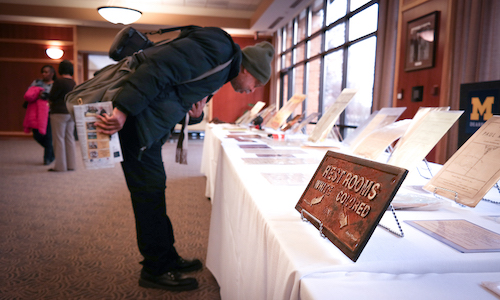
Khalid el-Hakim’s guest lecture at UM-Dearborn last Wednesday actually began with 15 minutes of relative silence. Those opening moments were reserved so that students and other members of the audience could take in—on their own, without much context—the few hundred objects laid out on tables before them.
There was everything from a recent GQ cover featuring NFL quarterback and activist Colin Kaepernick, to a set of shackles once used to bind enslaved people; racist advertisements from the not-so-distant past, to the socially conscious Public Enemy albums el-Hakim said ignited his own passion for black history. “Read the lyrics of Public Enemy, and you have a history lesson right there,” he told the students.
It was just a sampling of the 7,000-plus historical artifacts in el-Hakim’s Black History 101 Mobile Museum, which he brought as part of a special lecture to Education Professor Julie Anne Taylor’s multicultural education course. el-Hakim said that the power of teaching with artifacts is often rooted in their ability to make us uncomfortable.
“What I’ve observed is that people may have seen an object like a segregation sign in a documentary or a textbook,” el-Hakim said. “But to actually see a segregation sign up close brings a reality to it. You see it and touch it, and you realize there are people who produced these objects and experienced them as part of their lives.”
And in his lecture, el-Hakim demonstrated that some of the more profound moments of head-shaking can actually be generated by objects from more recent history—like a controversial 2008 Vogue cover featuring NBA star Lebron James as a King Kong-like figure. “They played him and he didn’t even know it,” el-Hakim explained to the students. “This is how deeply rooted these stereotypes are.”
Taylor, who also hosted el-Hakim in another course last fall, commented on the importance of engaging students in the direct examination of primary source materials—like photographs, documents and objects. She said analyzing evidence is considered a best practice in social studies education.
“Khalid has such a powerful way of presenting evidence,” Taylor said. “For example, last fall, he actually demonstrated—using his own body—how the shackles would have been put on people and would have affected their posture when trying to walk. He rendered something that is hard to comprehend, and he made it clear to us.”
The concept behind the collection, el-Hakim explained, is to harness the power of historical objects to “prick the consciousness”—and spark challenging discussions about both black history and its continuity with current issues surrounding race in America.
The last words of the evening came from a student, junior Etana Fields-McCurdy, who acknowledged that historical awareness is critical.
“I do think that sometimes we get comfortable,” she told el-Hakim directly at the close of the lecture. “And you’ve made us feel uncomfortable. No matter how much we’ve overcome, or how much we’ve grown, it’s important to be reminded of the challenges that are still with us. So I want to thank you for that.”




